

Outlook

We hope we’ve shown you how visionaries, game changers, and challengers can tackle the vital issue of business models. We hope we’ve provided you with the language, the tools and techniques, and the dynamic approach needed to design innovative and competitive new models. But much remains to be said. So here we touch on five topics, each of which might well merit its own book.
The first examines business models beyond profit: how the Canvas can drive business model innovation in the public and non-profit sectors. The second suggests how computer-aided business model design might leverage the paper-based approach and allow for complex manipulation of business model elements. The third discusses the relationship between business models and business plans. The fourth addresses issues that arise when implementing business models in either new or existing organizations. The final topic examines how to better achieve business model and IT alignment.
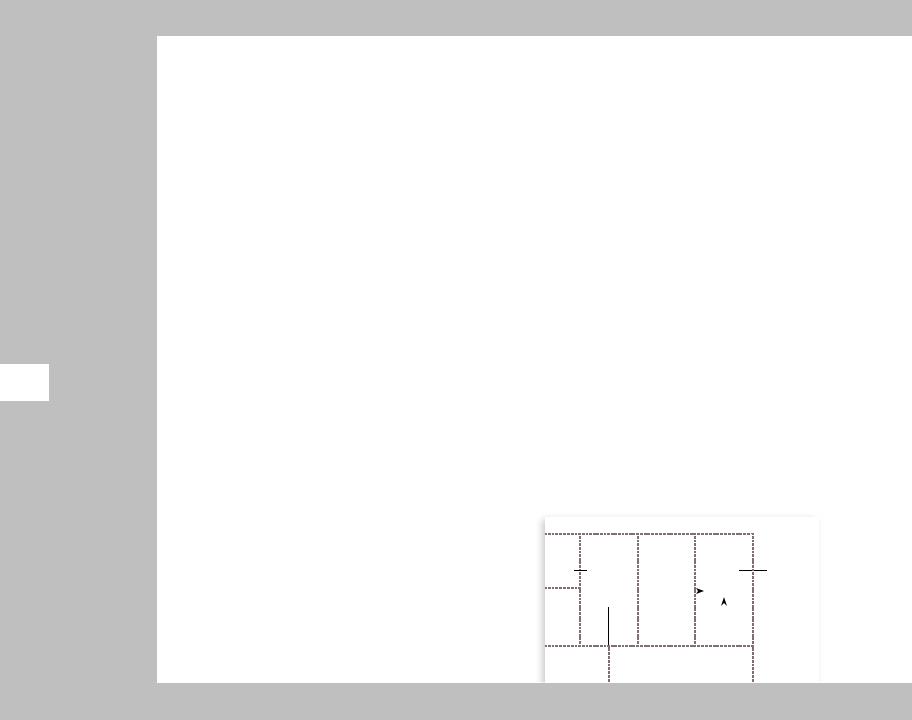
Beyond-Profit Business Models
The application of the Canvas is in no way limited to for-profit corporations. You can easily apply the technique to non-profit organizations, charities, public sector entities, and for-profit social ventures.
Every organization has a business model, even if the word “business” is not used as a descriptor. To survive, every organization that creates and delivers value must generate enough revenue to cover its expenses. Hence it has a business model. The difference is merely a matter of focus: the for-profit business’s goal is to maximize earnings, while the organizations discussed in the following pages have strong non-financial missions focused on ecology, social causes, and public service mandates. We find useful entrepreneur Tim Clark's suggestion that the term “enterprise model” be applied to such organizations.
We distinguish between two categories of beyond-profit models: third-party funded enterprise models (e.g. philanthropy, charities,
264 government) and so-called triple bottom line business models with a strong ecological and/or social mission (“triple bottom line” refers to the practice of accounting for environmental and social, as well as financial, costs). It is mainly the source of revenue that distinguishes these two, but as a direct consequence they have two very different business model patterns and drivers. Many organizations are experimenting with blending the two models in order to exploit the best of both.
Third-Party Funded Models
In this type of enterprise model, the product or service recipient is not the payer. Products and services are paid for by a third party, which might be a donor or the public sector. The third party pays the organization to fulfill a mission, which may be of a social, ecological, or public service nature. For example, government (and indirectly, taxpayers) pays schools to deliver education services. Likewise,
donors to Oxfam, a large U.K. non-profit organization, help finance its efforts to end poverty and social injustice. Third parties rarely expect to receive direct economic benefits from the exchange, unlike advertisers—who are players in for-profit business models which also feature third party financing.
One risk of the third-party enterprise model is that value creation incentives can become misaligned. The third-party financer becomes the main “customer,” so to speak, while the recipient becomes a mere receiver. Since the very existence of the enterprise depends on contributions, the incentive to create value for donors may be stronger than the incentive to create value for recipients.
All this is not to say that third-party funded enterprise models are bad and recipient-funded business models are good. Conventional businesslike selling of products and services doesn’t always work: education, healthcare, and utility services are clear examples. There are no simple answers to the questions raised by third-party financed enterprise models and the resulting risks of misaligned incentives. We must explore which models make sense, then strive to design optimal solutions.
VP CR CS
 mission
mission  “donor”
“donor”
product or  “recipient” service Ch
“recipient” service Ch
R$ |
free |
|
|
|
donation |
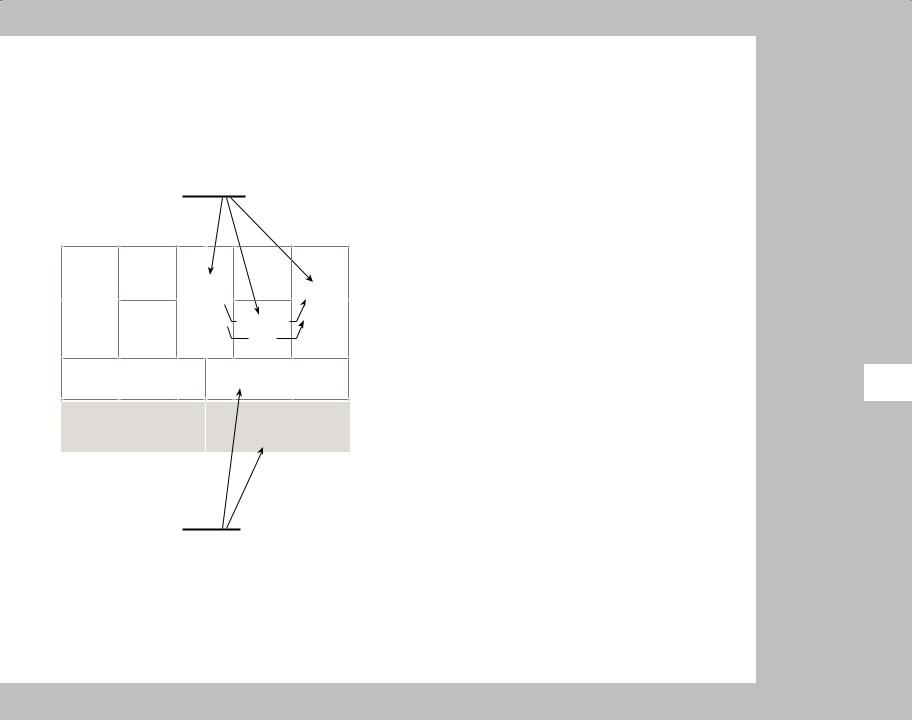
Villagers in Bangladesh were too poor to afford phones, so Grameenphone partnered with Grameen Bank, the microfinance institution, to provide local women with microloans to purchase mobile phones. The women sold calling
services in their villages, repaid the loans, earned income, and thereby improved their social status.
KP |
KA |
VP |
CR |
CS |
|
manage |
|
|
|
|
network |
|
|
|
grameen bank |
|
income |
|
village phone |
|
opportunity |
|
ladies |
|
network |
|
|
||
KR |
|
Ch |
|
|
consortium |
|
|
||
(telenor) |
mobile |
villagers |
||
|
network |
communication |
grameen bank |
|
|
|
village phone |
|
|
|
|
|
ladies |
|
C$ |
network |
R$ |
communication income |
|
|
|
|||
social and environmental costs |
social and environmental benefits |
“universal access”
income for women and better social status
Grameenphone went beyond establishing near universal access to telephone service and earning a profit. It also had substantial social impact by providing “village phone ladies” with earning opportunities and improved social status.
Solving the big issues of our generation requires bold new business models
Triple Bottom Line Business Models
Earlier we shared the story of how Iqbal Quadir, an investment banker in New York, set out to build Grameenphone. His goal was to provide universal access to telecommunications services in remote, rural areas of his home country of Bangladesh. He achieved his aim with a for-profit model that had a profound, positive impact on rural Bangladesh. Grameenphone eventually provided over 200,000 women in rural areas with income-earning opportunities, raised their
social status, connected 60,000 villages to a mobile phone network, 265 reached 100 million people, turned a profit, and became the Bangla-
deshi government’s biggest taxpayer.
To accommodate triple bottom line business models, we can extend the Canvas with Blocks illustrating two outcomes: (1) the social and environmental costs of a business model (i.e. its negative impact), and (2) the social and environmental benefits of a business model (i.e. its positive impact). Just as earnings are increased by minimizing financial costs and maximizing income, the triple bottom line model seeks to minimize negative social and environmental impacts and maximize the positive.

Computer-Aided Business Model Design
Mike, a senior business analyst with a large financial group, wraps up the first of a two-day workshop he is facilitating with a group of 24 executives. He collects the business model prototypes and ideas that participants sketched on large Canvas posters and hurries to his office. There, Mike and his team enter the ideas into a collaborative computer-aided business model design program to further develop
the prototypes. Other business analysts working overseas add resource and activity cost estimates, as well as calculations of potential Revenue Streams. The software then spits out four different financial scenarios, with business model data and prototype diagrams for each plotted on large posters. The following morning Mike presents the results to the executives, who have gathered for the second day of their workshop to discuss the potential risks and rewards of each prototype.
266 This scenario doesn’t yet describe reality, but it soon will. A Business Model Canvas printed on a large poster and a big box of Post-it™ notes are still the best tools for triggering creativity and generating innovative business model ideas. But this paper-based approach could be extended with the help of computers.
Turning a prototype business model into a spreadsheet is timeconsuming, and each change to the prototype usually requires a manual modification of the spreadsheet. A computer-aided system could do this automatically and make possible lightning-quick, comprehensive business model simulations. Furthermore, computer
support could make creating, storing, manipulating, tracking, and communicating business models far easier. Such support would seem to be almost a requirement for collaboratively working on business models with geographically disparate teams.
Doesn’t it seem strange that we can design, simulate, and build airplanes or develop software across continents, yet we can’t manipulate highly valuable business models outside of the boardroom and without paper and pencil? It’s time to bring the speed and power of microprocessors to the development and management of
new business models. Inventing innovative business models certainly requires human creativity, but computer-aided systems could help us manipulate business models in more sophisticated and complex ways.
An example from the field of architecture is helpful in illustrating the power of computer-aided design. In the 1980s so-called Computer-Aided Design (CAD) systems started becoming more affordable and slowly were adopted by architectural firms. CAD made it much easier and cheaper for architects to create threedimensional models and prototypes. They brought speed, integration, improved collaboration, simulation, and better planning to architecture practices, Cumbersome manual tasks, such as constant redrawing and blueprint sharing, were eliminated, and a whole new world of opportunity, such as rapid visual 3D exploration and prototyping, opened up. Today paper-based sketching and CAD happily co-exist, each method retaining its own strengths and weaknesses.
Prototype of a computer aided business model editor: www.bmdesigner.com

In the realm of business models, too, computer-aided systems could make many tasks easier and quicker, while revealing as-yet unseen opportunity. At the least, CAD systems could help visualize, store, manipulate, track, annotate, and communicate business models. More complex functions would involve manipulating layers or business model versions, or moving business model elements dynamically and evaluating the impact in real-time. Sophisticated systems might facilitate business model critiquing, provide a reposi-
tory of business model patterns and off-the-shelf building blocks, enable distributed business model development and management, simulate models, or integrate with other enterprise systems (e.g. ERP or business process management).
Computer-aided business model design systems will likely evolve in step with interface improvements. Manipulating business models on wall-sized touch screens would bring computer-aided design closer to the intuitive paper-based approach and improve usability.
Applications Advantages
Paper-based |
Computer-aided |
|
• Paper or poster-based Canvases can be easily created |
Easy to create, store, manipulate, and track business models |
|
267 |
||
and used just about anywhere |
• Enable remote collaboration |
|
• Paper and poster-based Canvases impose few barriers: |
• Quick, comprehensive financial, other simulations |
|
no need to learn a specific computer application |
• Provide business model design guidance (critiquing |
|
• Very intuitive and engaging in group settings |
systems, business model database, pattern ideas, |
|
• Fosters creativity, spurs ideation when used on large surfaces |
control mechanisms) |
|
• Napkin sketches to draw, understand, or explain |
• Collaborative business model design with remote teams |
|
business models |
• Complex manipulations of business models (navigation, |
|
• Collaborative brainstorming sessions to develop |
business model layers, merging models) |
|
business model ideas |
• Deep, comprehensive analysis |
|
• Collaborative assessment of business models |
|
|

Business Models and Business Plans
The purpose of a business plan is to describe and communicate a for-profit or non-profit project and how it can be implemented, either inside or outside an organization. The motivation behind the business plan may be to “sell” a project, either to potential investors or internal organizational stakeholders. A business plan may also serve as an implementation guide.
In fact, the work you may have done designing and thinking through your own business model is the perfect basis for writing a strong business plan. We suggest giving business plans a five-section structure: The Team, The Business Model, Financial Analysis, External Environment, Implementation Roadmap, and Risk Analysis.
The Team
One business plan element that venture capitalists particularly 268 emphasize is the management team. Is the team experienced, knowl-
edgeable, and connected enough to accomplish what they propose? Do the members have successful track records? Highlight why your team is the right one to successfully build and execute the business model you propose.
The Business Model
This section showcases the attractiveness of the business model. Use the Canvas to provide readers with an immediate visual portrait of your model. Ideally, illustrate the elements with drawings. Then, describe the Value Proposition, show evidence of customer need, and explain how you will reach the market. Use stories. Highlight the attractiveness of your target segments to pique the reader’s interest. Finally, describe the Key Resources and Activities needed to build and execute the business model.
Financial Analysis
This is traditionally an important business plan component that attracts much attention. You can make pro forma calculations based on your Canvas Building Blocks and estimate how many customers can be acquired. Include elements such as breakeven analysis, sales scenarios, and operating costs. The Canvas can also help with capital spending calculations and other implementation cost estimates. Total cost, revenue, and cash flow projections determine your funding requirements.
External Environment
This section of the business plan describes how your business model is positioned with respect to the external environment. The four external forces covered earlier (see p. 201) provide the basis for this description. Summarize your business model’s competitive advantages.
Implementation Roadmap
This section shows the reader what it will take to implement your business model and how you will do it. Include a summary of all projects and the overarching milestones. Outline the implementation agenda with a project roadmap that includes Gantt charts. Projects can be derived directly from your Canvas.
Risk Analysis
In closing, describe limiting factors and obstacles, as well as critical success factors. These can be derived from a SWOT analysis of your business model (see p. 216).
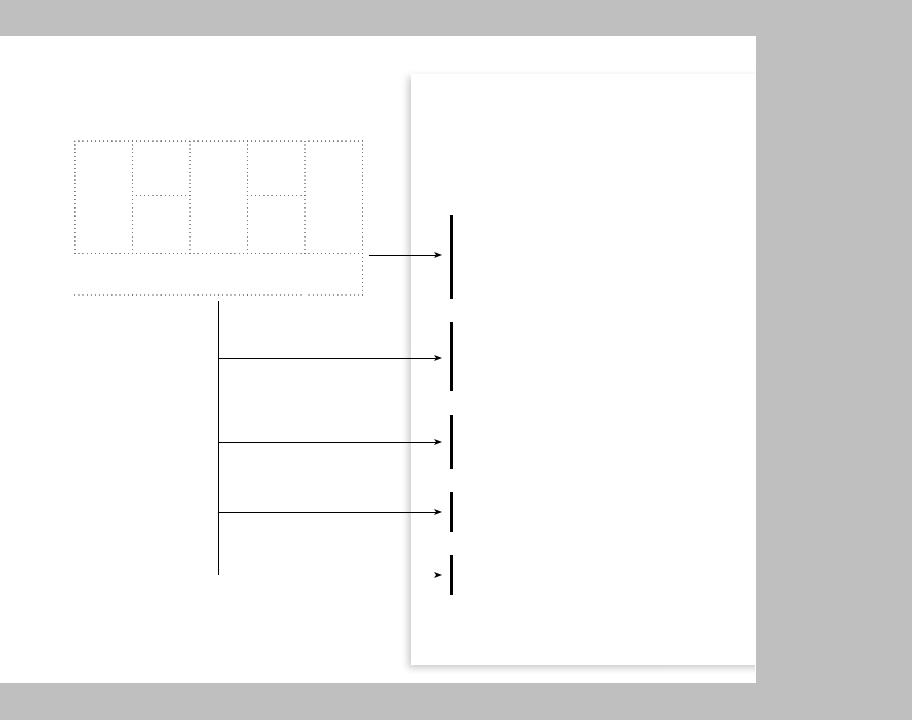
KP |
KA |
VP |
CR |
CS |
|
KR |
|
Ch |
|
 C$
C$  R$
R$
financial spreadsheets
environmental analysis
implementation roadmap
SWOT and uncertainty analysis
BUSINESS PLAN
executive summary
the team
• Management Profile
• Why We Are a Winning Team
the business model
• Vision, Mission, and Values
• How Our Business Model Works • Value Proposition
• Target Markets • Marketing Plan
• Key Resources and Activities financial analysis
• Breakeven Analysis |
|
|
|
• Sales Scenarios and Projections |
|
|
|
• Capital Spending |
|
|
|
• Operating Costs |
|
|
|
|
269 |
|
|
• Funding Requirements |
|
|
|
external environment |
|
|
|
|
|
|
|
• The Economy |
|
|
|
• Market Analysis and Key Trends |
|
|
|
• Competitor Analysis |
|
|
|
• Competitive Advantages of Our Business Model |
|
|
|
implementation roadmap |
|
|
|
• Projects |
|
|
|
• Milestones |
|
|
|
• Roadmap |
|
|
|
risk analysis |
|
|
|
• Limiting Factors and Obstacles |
|
|
|
• Critical Success Factors |
|
|
|
• Specific Risks and Countermeasures |
|
|
|
conclusion |
|
|
|
annexes |
|
|
|

Implementing Business Models in Organizations
We’ve laid out the fundamentals of business model innovation, explained the dynamics of different patterns, and outlined techniques for inventing and designing models. Naturally there is much more to say about the implementation that is critical to a business model’s success.
We’ve already addressed the question of how to manage multiple business models (see p. 232). Now let’s turn to another aspect of implementation: turning your business model into a sustainable enterprise, or implementing it in an existing organization. To illustrate, we’ve combined the Canvas with Jay Galbraith’s Star Model to suggest aspects of organizational design you may want to consider when executing a business model.
Galbraith specifies five areas that should be aligned in an organization: Strategy, Structure, Processes, Rewards, and People. We place 270 the business model in the middle of the star as a “center of gravity”
that holds the five areas together.
Strategy
Strategy drives the business model. Do you want to grow 20 percent in new market segments? Then that should be reflected in your business model in terms of new Customer Segments, Channels, or Key Activities.
Structure
The characteristics of a business model determine the optimal organizational structure for its execution. Does your business model call for a highly centralized or decentralized organizational structure? If you will implement the model in an established business, should the new operation be integrated or spun off (see p. 233)?
Processes
Each business model demands different processes. Operations run under a low-cost business model should be lean and highly automated. If the model calls for selling high-value machines, quality processes must be exceptionally rigorous.
Rewards
Different business models require different reward systems. A reward system must use appropriate incentives to motivate workers to do the right things. Does your model require a direct sales force to acquire new customers? Then your reward system should be highly performance oriented. Does your model depend heavily on customer satisfaction? Then your reward system must reflect that commitment.
People
Certain business models call for people with particular mindsets. For example, some business models call for particularly entrepreneurial mechanisms to bring products and services to market. Such models must give employees significant leeway, which means hiring proactive, but dependable, free-thinkers.
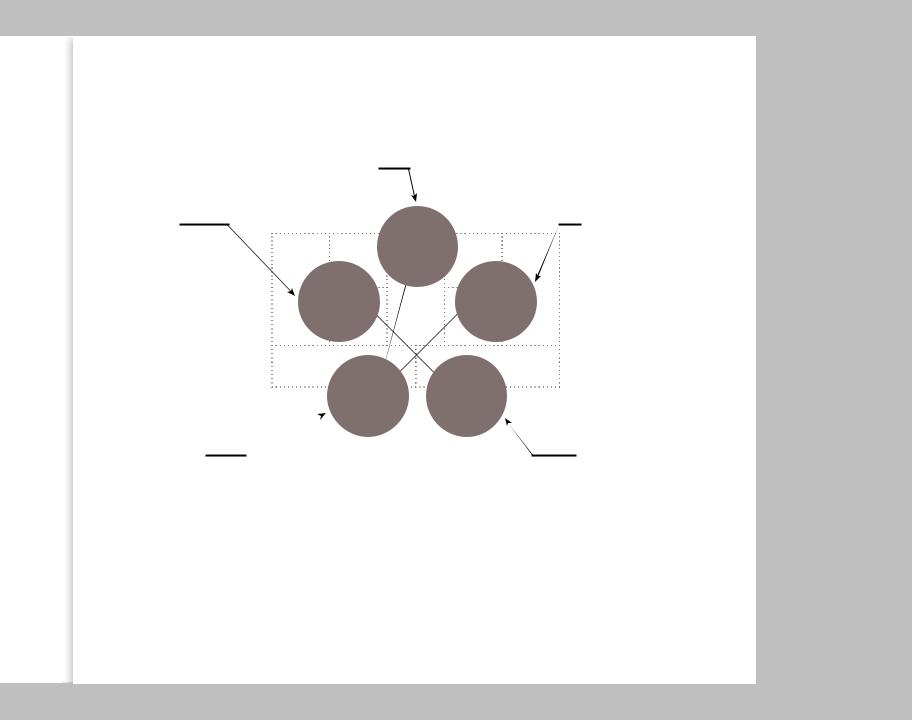
Skills/mindset
What kinds of people with what skills does your business model require? What type of mindset is needed?
Direction
What are your strategic goals? How do they drive the business model?
Power
What type of organizational structure does your business model require?
KP |
KA |
VP |
CR |
|
CS |
||
|
|
|
strategy |
|
|
|
|
|
KR |
|
|
Ch |
|
|
|
|
people |
|
|
structure |
|||
C$ |
|
|
R$ |
|
|
|
|
|
|
|
|
|
|
|
|
|
rewards |
|
processes |
271 |
|||
|
|
|
|||||
Motivation
What reward system does your business model require? How can you motivate your people?
Information
What information flows, processes, and workflows does your business model require?

Aligning IT with Business
Aligning information systems and business goals is fundamental to the success of an enterprise. Chief executives officers ask their chief information officers (CIOs), Do we have the right IT? How do we know? How can we best align our business with our technology systems?
Information technology research and advisory firm Gartner highlights this issue in a report called “Getting the Right IT: Using Business Models.” Gartner asserts that the Business Model Canvas is a powerful tool that helps CIOs quickly grasp how a business works without getting bogged down in operational details. Gartner recommends that CIOs use the Business Model Canvas to align IT and key business processes. This helps them align business and IT decisions without diving too deeply into tactical issues.
We find it useful to pair the Canvas with an Enterprise Archi- 272 tecture approach. Many of the various Enterprise Architecture
concepts describe the enterprise from three perspectives: the business perspective, the applications perspective, and the technology perspective. We recommend using the Canvas to guide the business perspective, then align the business with the applications and technology perspectives.
In the application perspective, you describe the portfolio of applications that leverage aspects of your business model (e.g. recommendation systems, supply chain management applications, etc.) and you describe all the business model’s information requirements (e.g. customer profiles, warehousing, etc.). In the technology perspective you describe the technology infrastructure that drives your business model (e.g. server farms, data storage systems, etc.).
Authors Weill and Vitale propose another interesting way to explore IT alignment. They pair categories of IT infrastructure service with business models. Weill and Vitale propose aligning business models with application infrastructure, communications management, data management, IT management, security, IT architecture, channel management, IT research and development, and IT training and education.
On the opposite page we’ve brought these elements together in a graphic to help you pose some fundamental questions regarding business and IT alignment.
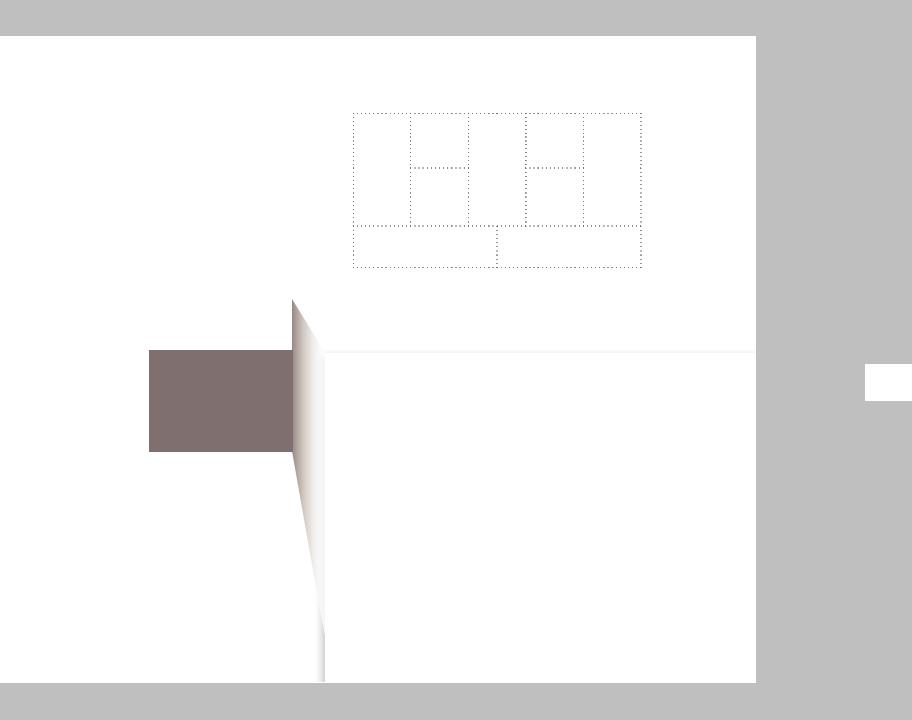
KP |
KA |
VP |
CR |
CS |
|
KR |
|
Ch |
|
C$ |
|
|
R$ |
|
strategy |
|
business model |
Business |
operational models |
|
|
|
Applications
How can IT support the processes and workflows required by my business
models?
Technology
What information do I need to capture, store, share, and manage to improve my business model?
How does my application portfolio leverage the specific dynamics of my business model?
How will IT architecture, standards, and interface choices limit or leverage my business model?
Which technology infrastructure is required and crucial to the success of my business model (e.g. server farms, communications, and so on)?
Where in my business model does |
273 |
security play an important role and how does that influence my IT?
Do I need to invest in IT training
and education to leverage my business model?
Could investments in IT research
and development improve my business model in the future?
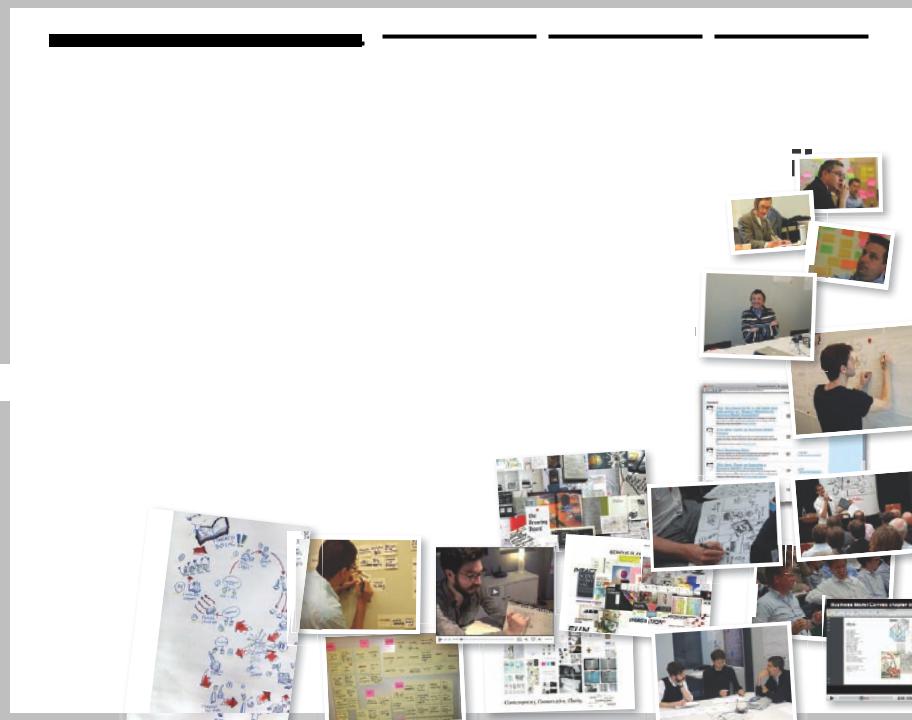
WhERE DID ThIS BOOK 274 COME
FROM?
Context
2004: Alexander Osterwalder completes a Ph.D. dissertation on the topic of business model innovation with
ProfessorYvesPigneurathECLausanne, Switzerland. Fast forward. 2006: The approach outlined in the dissertation starts being applied around the world based on Alexander’s business model blog, notably in companies such as 3M,
Ericsson, Deloitte, and Telenor. During a workshop in the Netherlands Patrick van der Pijl asks “why is there no book accompanying the method?”
Alexander and Yves take up the challenge. But how does one stand out in a market where countless strategy and management books are published every year?
INNOVATING the model
AlexanderandYvesdecidethey can’t credibly write a book about business model innovation without an innovative business model.
Theyditchpublishersandlaunchthe hub,anonlineplatformtosharetheir writingsfromdayone.Anybodywith aninterestinthetopiccanjointhe platformforafee(initiallyu.S.$24, whichisgraduallyraisedtou.S.$243to keepthe platformexclusive).That this and other innovativeRevenue Streams finance the book productioninadvance itselfis aninnovation as well.Itbreaks theformatofconventional strategy and management booksinorder tocreate morevalue for readers: itisco-created highly visual,and complemented by exercises and workshop tips.
key audience visionary and game changing . . .
entrepreneurs / consultants / executives
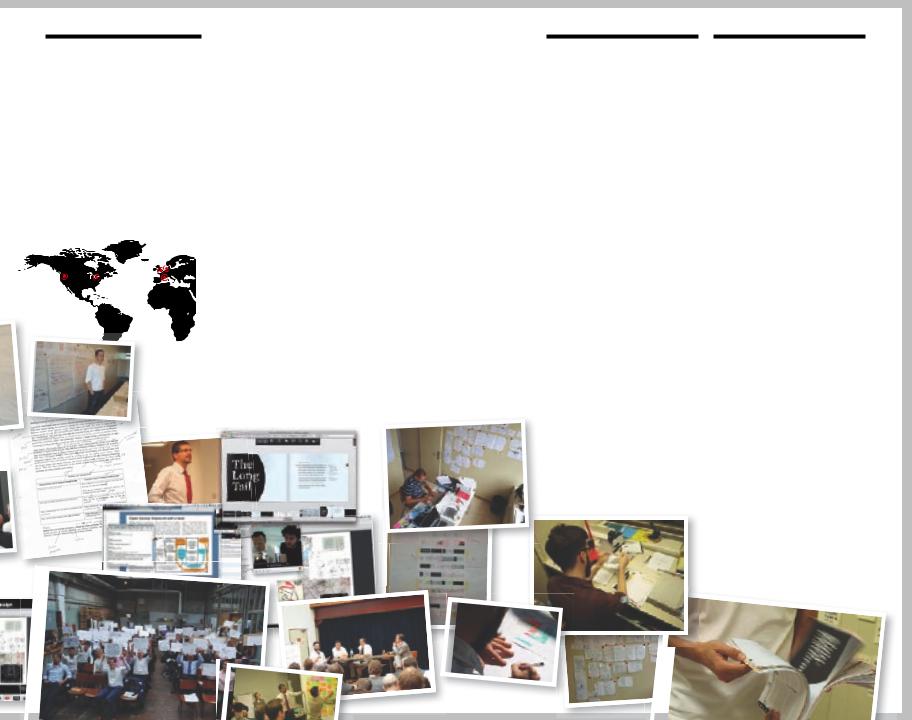
MADEIN...
Written: Lausanne, CH
Designed: London, UK
Edited: Portland, USA
Photographed: Toronto, CA
Produced: Amsterdam, NL
Events: Amsterdam & Toronto
process
The core team, consisting of Alexander, Yves, and Patrick start the project with a number of meetings to sketch out the business model of the book. The Hub is launched to co-create the book with business model innovation practitioners throughout the world. Creative Director Alan Smith of The Movement hears about the project and puts his company behind it. Finally, Hub member Tim Clark joins the core team after recognizing the need for an editor. The group is completed by JAM, a company that uses visual thinking to solve business problems. An engagement cycle is started to pump fresh “chunks” of content out to the Hub community for feedback and contributions. The writing of the book becomes completely transparent. Content, design, illustrations, and structure are constantly shared and thoroughly commented upon by Hub members worldwide. The core team responds to every comment and integrates the feedback back into the book and design. A “soft launch” of the book is organized in Amsterdam, Netherlands, so members of the Hub can meet in person and share their experiences with business model innovation. Sketching out participant business models with JAM becomes the core exercise of the day. Two hundred special limited edition prototypes of the (unfinished) book go to print and a video of the writing process is produced by Fisheye Media. After several more iterations the first print run is produced.
toolS uSeD
strategy:
•Environmental Scanning
•Business Model Canvas
•Customer Empathy Map content and r&d:
•Customer Insights
•Case Studies
open process:
•Online Platform
•Co-Creation
•AccesstounfinishedWork
•Commenting & Feedback design:
•Open Design Process
•Moodboards
•Paper Mockups
•Visualization
•Illustration
•Photography
the numbers
9 |
1,360 |
|
|
|
|
years of |
comments |
||||
research |
|||||
|
|
|
|
||
and practice |
45 |
|
|
|
|
470 |
countries |
||||
co-authors |
137,757 |
|
|
|
|
19 |
views of method |
||||
|
|||||
book chunks |
online before |
||||
book publishing |
|||||
|
|||||
8 |
13.18 |
|
|
|
|
prototypes |
GB of content |
||||
|
|||||
200 |
28,456 |
|
|
|
|
copies of a |
Post-it™ notes used |
|
|
|
|
|
|
|
|||
messed |
|
|
|
||
|
|
275 |
|
||
up test print |
4,000+ |
|
|
||
|
|
|
|||
77 |
|
|
|
||
hours of work |
|||||
|
|||||
forum |
521 |
|
|
|
|
discussions |
|
|
|
||
287 |
photos |
||||
|
|
|
|
||
Skype calls |
|
|
|
|
|
